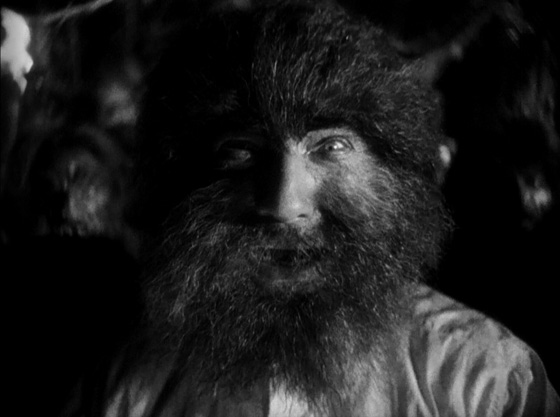
The infamous Island of Lost Souls (1932) was unavailable on home video through the years of the DVD explosion; Universal (the current rights holders), perhaps fearing that the condition of the film wasn’t up to snuff, kept it out of the public eye. A previous VHS release, along with occasional TV airings, were the only means to see the film – but it remained of great stature among monster movie fans and horror buffs. Now it’s available again, thanks to the Criterion Collection (and soon in England, via the Masters of Cinema imprint), and despite the nearly eighty years that have passed since its premiere, the film remains a feast; if you haven’t seen it before, it’s a revelation. The year of the film’s release is key. The 30’s are horror’s golden age, and for those first few years, when Boris Karloff and Bela Lugosi introduced monster-themed horror to Depression-era audiences, the Hays Code wasn’t around to hold them back. Island of Lost Souls, a Paramount picture based upon H.G. Wells’ The Island of Dr. Moreau, towers among those early gems as one of cinema’s most dark and disturbing fables.
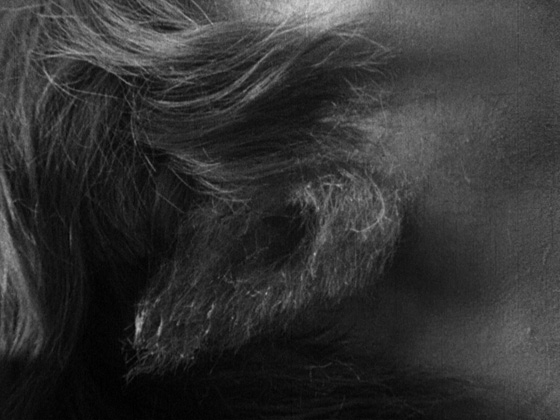
Parker notices something strange about M'ling's ear.
The film opens much the same as the book: a castaway, Edward Parker (Richard Arlen, Wings), is rescued onto a boat carrying strange cargo to a mysterious island not located on any map. He takes kindly to Montgomery (Arthur Hohl), an ex-doctor and alcoholic who nurses him back to health, and keeps an odd-looking servant named M’ling (Tetsu Komai). The ship is stocked with cages and cages of animals: a Noah’s Ark. After a row with the captain, Parker is abandoned to the port of call – an island sanctuary ruled by Montgomery’s employer, the mysterious Dr. Moreau (Charles Laughton of The Sign of the Cross and The Old Dark House, and an instant horror icon with this role). Moreau has been conducting experiments in the isolation of his tiny island, and though he doesn’t wish to discuss the research in any detail, Parker can’t help but notice that the island natives – whom the doctor beats with a whip – don’t seem entirely human. Moreau also seems unusually anxious to introduce Parker to a beautiful islander named Lota (newcomer Kathleen Burke, billed as “The Panther Woman”). Parker’s got a girl back home, but he’s intrigued by the sensuous, alluring Lota, with her broken English, revealing attire, and almost feline charms.
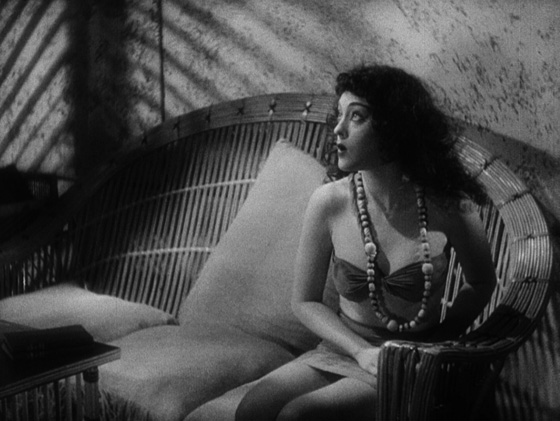
Lota the Panther Woman (Kathleen Burke)
The revelation, of course, is that Moreau has been experimenting upon animals, genetically altering them to bridge the evolutionary gap and make them humanoid. He hopes that Lota, his first female creation, is the breakthrough: so convincing a woman that she can seduce this stranger without him suspecting for a moment that she has a litter box in the next room. Moreau later makes it plain that he wants to mate the two before making his scientific discoveries public on his return home; he anticipates glory and the respect of his peers. Never mind that he acts the 19th-century slavemaster: brutally whipping his servants and forcing them into menial and sometimes torturous tasks. One of his creations, named the Sayer of the Law and played by an almost unrecognizable Bela Lugosi (if only that Hungarian accent didn’t give him away), keeps the creatures in line by conducting the same call-and-response dialogue, over and over: “What is the law? Not to run on all fours, that is the law! What is the law? Not to eat meat, that is the law! What is the law? Not to spill blood, that is the law! Are we not men?”
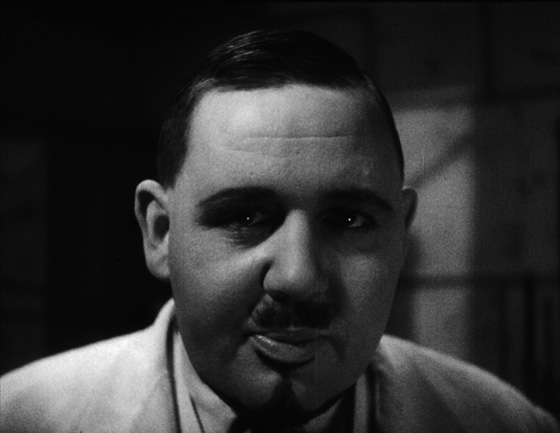
Charles Laughton as Dr. Moreau
Parker’s disturbing discovery of Moreau’s so-called “House of Pain” – where he experiments upon his creatures, who moan in agony – leads him to plot an escape with Lota. Moreau is so desperate to keep Parker prisoner that he has the boat in the harbor sunk. And Parker can’t trust himself to hide in the jungle, where the beast-men can hardly hold themselves in check to Lugosi’s spoken laws – no, as Moreau laments, despite all his efforts “the beast flesh keeps creeping back.” Lota sprouts sharp claws. And when Parker’s best gal, Ruth (Leila Hyams, Freaks), shows up on the island to stage a rescue with the ship captain who abandoned him there, the beast-men boldly break the Sayer’s laws and shed blood. Soon they’re taking up torches and laying siege to Moreau’s zoo-like fortress, to enact revenge on their sadistic creator.
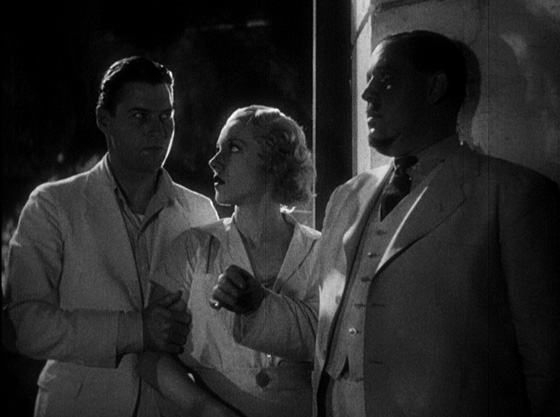
Their last night at Moreau's is a very long one: Richard Arlen as Parker, Leila Hyams as Ruth, and Charles Laughton.
Island of Lost Souls is chock-full of so many sublime moments that, pared down to a lean seventy minutes, it becomes poetry. Take, for example, the introduction of M’ling. The dog-man is introduced shaking his head just as a dog does (and which will trigger an instant migraine to any non-canine attempting the move). Or the moments which take place in the cave-passage that leads to the island’s interior: a dark and womb-like limestone corridor which inevitably reveals a terrible silhouette waiting at the far end. Or the close-ups of Moreau’s cherubic face, and every sinister grin which Laughton will reveal at the most inappropriate of moments. Or any scene involving Lota, who slinks into and out of the frames, posing her body and becoming perfectly still while she watches, and then glides up and over the architecture noiselessly. But there are two main reasons why I love this film. One is Laughton, whose performance elevates the material: watch as we first see him and Lota alone, and he prepares to introduce her to Parker. He paces quietly, in complete command without saying a word: she watches him in fear. When he speaks, he’s like an abusive father: there’s a hint of threat in his seemingly kind words. His final fate is both gratifying and horrific – shades of Freaks, released the same year, and the only film of its time even more notorious than this one.
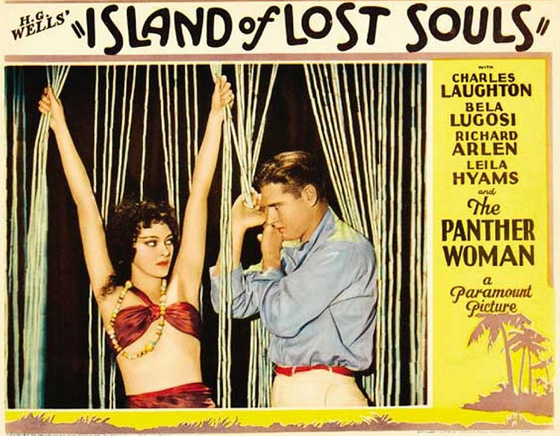
A lobby card, presenting a moment not actually in the film.
The other reason I adore this film is the world it creates for us to inhabit, a completely tactile and sensory environment. Director Erle C. Kenton realizes Moreau’s island so crisply that by the film’s end, any audience member should be able to draw a map. It’s an efficient but endlessly creative use of limited sets and rear projection. Note that in nearly every jungle shot, something is moving off in the background. The effect is eerie and claustrophobic: there is no safe place to hide if the beast-men get out of line. As the film progresses, and the danger closes in on Moreau’s abode, the true horror of the piece becomes clear. In one scene, an ape-man glimpses through a window Ruth undressing down to her silk slip. After she goes to sleep, we watch as the creature leaps up to the window, greedily looks inside, and then methodically dismantles the bars that separate them. Meanwhile, we know that Parker has asked her to lock her door – so when the creature prepares to ravish her, there’s seemingly no means to rescue her in time. The film is rich with such carefully orchestrated suspense. The structure of Wells’ novel is altered (at least, to my memory – I haven’t read it since I was a teenager), but only to the better: Kenton intercuts between scenes on the island with Ruth’s efforts to send a rescue party after Parker. As Parker falls into greater danger with Moreau, we see the would-be cavalry arriving, step by step, creating a narrative thrust: which is effectively undone when they prove to be little help after all.
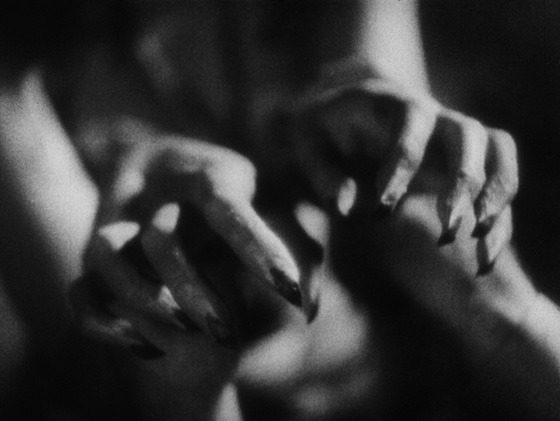
"The beast-flesh keeps creeping back": Lota shows her claws.
The film has grown no less relevant with age, particularly in the era of cloning and genetic manipulation, and the ethical questions they present. Island of Lost Souls keeps its science vague, and perhaps that’s for the best: you can write your own explanations for how Moreau is achieving what he does, just so long as it involves a treadmill wheel operated by the feet of beast-men. Being pre-Code, it also makes some daring suggestions of sex (with “panther woman” Lota, a prospect I’m sure many of the men in the audience wouldn’t have hesitated to consider) and sadistic mutilation. Lugosi’s part is disappointingly small, a foreshadowing of the direction his career would take after Dracula (1931): increasingly sidelined, straight to Poverty Row. But he’s memorable nonetheless. Laughton, on the other hand, took a bee-line for greatness: he would go on to play the title character of The Hunchback of Notre Dame (1939), as well as Henry VIII in The Private Life of Henry VIII (1933), Bligh in Mutiny on the Bounty (1935), and numerous other high-profile roles straight on through Spartacus (1960). H.G. Wells’ novel was filmed again (fairly respectably) in 1977 with Michael York as the protagonist and Burt Lancaster as Moreau, but unfortunately the film which overshadows all adaptations is the 1996 version with Marlon Brando. I would humbly suggest that Laughton’s Moreau wipes the floor with Brando’s. And for sheer spooky horror, Island of Lost Souls remains formidable: perfect Halloween viewing.









